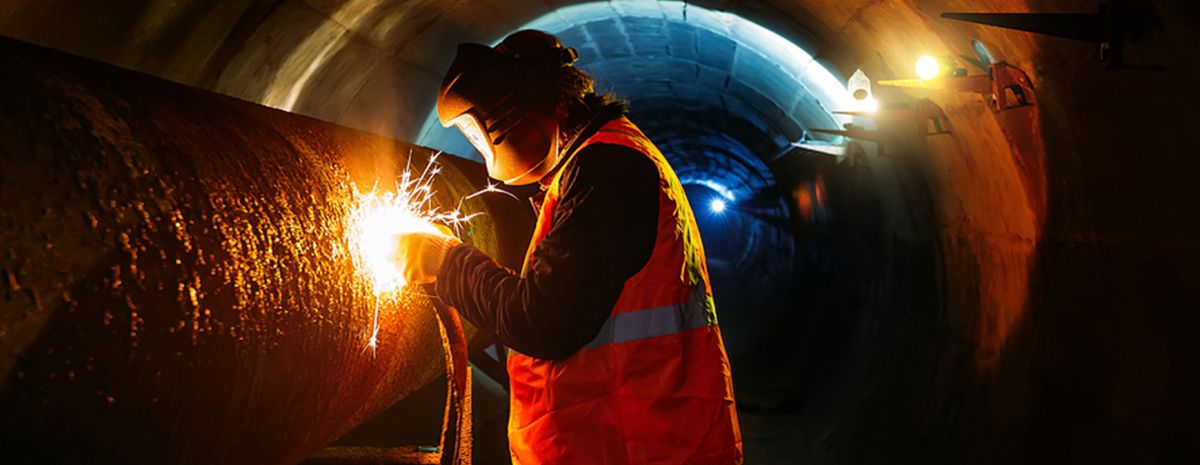TWS is a Great Training Option for Everyone
Learn more about how we can prepare you to advance your career.
Gas tungsten arc welding, more commonly known as TIG welding, is a complex and refined welding technique resulting in high-quality, durable, and strong welding bonds. Many welders struggle to perfect this welding method due to its intricacies and precision. Mastering this advanced welding technique is a great way to improve your competitiveness in the field and further your career.
Why is TIG welding so tricky?
TIG welding is considered much harder to learn and execute than other forms of welding such as MIG welding.
While welders can keep one hand free when using different techniques, TIG welding requires the use of both hands. One hand is holding the welding torch while the other continues to feed the filler material, limiting mobility and demanding more attention to detail.
TIG welding also takes longer to complete due to increased preparation time and the need for sparkling clean surfaces. The complexity of TIG welding translates into extended training and practice since it takes longer for welders to perfect the technique.
Have You Considered a Career in the Skilled Trades?
Fill out the form to recieve a no obligation info packet.
The tradeoff to TIG welding’s elevated difficulty is the stronger and longer-lasting welds it yields when compared to other methods.
Tips to master TIG welding.
Keep all surfaces clear of debris.
TIG welding doesn’t perform well on unclean surfaces. Even the smallest contaminants can ruin a TIG weld.
Before you get started, make sure all your surfaces are completely clear of any debris including dust, dirt, and metal shavings. Use a solid degreaser on the base metal and follow it up with a thorough scrubbing with a metal brush. Be sure to use a different brush for each type of metal. When working with stainless steel, aluminum, and other softer metals, it’s advisable to use a delicate brush.
Hold the torch at a 15-degree angle.
When held at the wrong angle, the welding torch can prevent you from seeing the weld puddle completely while limiting space for the filler rod.
Although it depends on personal preference and the particular task, holding the torch at a 15-to-20-degree angle from the base metal is a great place to start. Anything above 45-degrees can cause a loss of shielding gas coverage.
On the other hand, a tighter angle can result in a misshaped welding puddle.
Get comfortable before starting.
TIG welding requires the electrode tip and the base metal to remain incredibly close without touching.
Throughout the weld, it’s necessary to stay within 1/8 to 3/16 of an inch. Even the slightest point of contact can result in a contaminated electrode making it harder to remain precise due to a misshaped arc cone.
Taking time to get as comfortable as possible before starting a TIG weld can decrease the likelihood of making this contact.
Pull instead of push.
When advancing their welding abilities, many trainees wonder, “Do you push or pull TIG welding?”
Although the push and pull methods work fine on MIG welding and other less-precise techniques, TIG welding is much more demanding.
As a result, you should stick with pull welding when performing TIG welds. This requires welders to drag the electrode in the opposite direction from the depositing metal, so the rod is angled towards the puddle.
Pulling allows for better penetration, stronger bonding, and a long-lasting finish.
Control the level of power.
Everything about TIG welding is precise. Even the amount of power you use needs to remain controlled to create the strongest weld possible. There’s a higher chance of having the weld burn through completely when using too much power.
The key is to use a manageable power setting that gives you enough to execute your puddle technique without becoming overpowered. When you can achieve a TIG weld with a minimum amount of power, the bond is strong and durable.
End the weld slowly.
As you reach the end of a TIG weld, it’s important to control the finish. Completing too abruptly can disrupt the welding shielding gas and compromise the quality of the weld.
The weld is piping hot, and removing the heat too quickly can result in cracking, craters, and other imperfections.
The key is to slowly reduce the arc in a controlled manner to protect your weld. This ensures shielding gases remain in place for a bit longer to prevent contamination.
Swap out your consumables.
TIG welding isn’t as messy as other welding techniques, since it doesn’t produce splatter or sparks. Still, it’s common for contaminants from the previous material to attach to your welding consumables.
When the project requires you to bounce between different metals, it’s advisable to swap out your consumables too. This prevents remnants from disrupting future welds. It’s especially important when working with softer metals such as aluminum or stainless steel since they’re tougher to clean.
Interested in learning more about this precise welding technique? Read about the different kinds of TIG welding applications. Interested in learning more about welding training at Tulsa Welding School? Contact us now.






